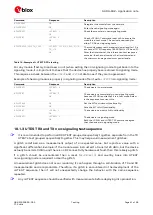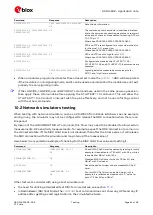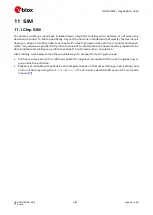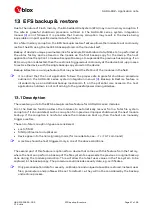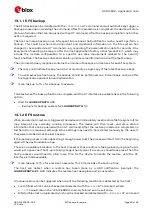
SARA-R42 - Application note
UBX-20050829 - R02
PSM, eDRX and deep-sleep mode
Page 33 of 58
C1-Public
depend on any previous RRC connection release. The negotiated T3324 and T3412 timers are also
highlighted: eDRX is used during the T3324 active time.
1.
The device is in PSM deep-sleep state, not responsive to AT commands nor paging messages. It
has already registered at startup, negotiating PSM timers.
2.
PSM is exited at early wake-up triggered by the host application or at T3412 timeout.
3.
In case of an early wake-up the host application is expected to start a MO transmission. If a
T3412 timeout occurs, the device sends a TAU keepalive message, performing a new PSM and
eDRX negotiation. The device re-connects to the network.
4.
Once the data or control packet transmission or reception is complete, the RRC connection is
released by the network. The device enters the idle state and starts T3324 and T3412 timers.
5.
While the T3324 timer is running, paging is listened to as per eDRX and DRX configuration.
6.
PSM is entered after T3324 has elapsed. Operations continue as per point 1.
If after point 2 the device does not enter RRC connected state, the device will eventually re-enter PSM
state as if it had not awakened from it.
TAU
/ MO
data
PSM
T3412
T3324
T3412
MT data
can still be
sent
P
ag
in
g
P
ag
in
g
P
ag
in
g
P
ag
in
g
P
ag
in
g
P
ag
in
g
T
DRX
T
DRX
T
DRX
T
DRX
T
DRX
T
DRX
Network
activity
Connected
state
Idle state
MT data
can still be
sent while
waiting for
RRC
release
Connected
state
Idle state
RRC
connection
PSM
eDRX cycle (#N hyper-frames) eDRX cycle (#N hyper-frames)
T
paging window
T
paging window
TA
U
/ MO
data
RRC
Release
Time
RRC released
Figure 5: State transitions and module activity when both PSM and eDRX are enabled























